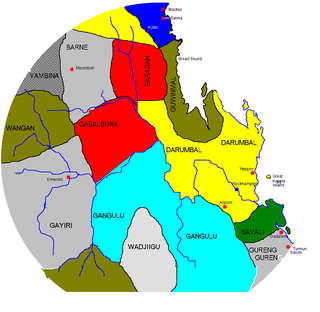
Norman Barnett Tindale AO was an Australian anthropologist, archaeologist, entomologist and ethnologist. He is best remembered for his work mapping the various tribal groupings of Aboriginal Australians at the time of European settlement, shown in his map published in 1940. This map provided the basis of a map published by David Horton in 1996 and widely used in its online form today. Tindale's major work was Aboriginal Tribes of Australia: Their terrain, Environmental Controls, Distribution, Limits and Proper Names (1974).

The Tangkic languages form a small language family of Australian Aboriginal languages spoken in northern Australia.
Doomadgee is a town and a locality in the Aboriginal Shire of Doomadgee, Queensland, Australia. It is a mostly Indigenous community, situated about 140 kilometres (87 mi) from the Northern Territory border, and 93 kilometres (58 mi) west of Burketown.
Ngardi, also spelt Ngarti or Ngardilj, is an Australian Aboriginal language that is considered moribund. It was previously thought to be an alternative name for the Bunara language, but these are now classified as separate languages. It was/is spoken by the Ngarti people of the Northern Territory and northern Western Australia.

The Shire of Mornington is a local government area in northwestern Queensland, Australia. The shire covers the Wellesley Islands, which includes Mornington Island; the South Wellesley Islands; Bountiful Islands; and West Wellesley / Forsyth Islands groups in the Gulf of Carpentaria.

Kayardild is a moribund Tangkic language spoken by the Kaiadilt on the South Wellesley Islands, north west Queensland, Australia. Other members of the family include Yangkaal, Lardil, and Yukulta (Ganggalidda).

The Aboriginal Shire of Doomadgee is a special local government area in North West Queensland, Queensland, Australia. It is managed under a Deed of Grant in Trust under the Local Government Act 2004.

The Paakantyi language, also spelt Paakantji, Barkindji, Barkandji, and Baagandji, and is also known as the Darling language, is a nearly extinct Australian Aboriginal language spoken along the Darling River in New South Wales from the present-day Queensland border to Bourke, then along the river to Wentworth. It includes much of the backcountry around the Paroo River, plus an area along Coopers Creek into Queensland and also through the Broken Hill district.

The Yukulta language, also spelt Yugulda, Yokula, Yukala, Jugula, and Jakula, and also known as Ganggalidda, is a Tangkic language spoken in Queensland and Northern Territory, Australia. It was spoken by the Yukulta people, whose traditional lands lie on the southern coast of the Gulf of Carpentaria.
Kukatj, also rendered Gugadj, is an extinct Paman language of the Cape York Peninsula, Queensland, Australia. The name Kalibamu has also been assigned to it, although this may be a separate dialect. It is spoken by the Kukatj people. A single speaker was last recorded in 1975.
Wanggamala, also spelt Wanggamanha, Wangkamahdla, Wangkamadla, Wangkamanha, Wangkamana, Wonkamala, Wongkamala, Wonkamudla, and other variants, is an extinct Australian Aboriginal language of the Pama–Nyungan family, previously spoken in the Northern Territory around Hay River and to the south of the Andegerebinha-speaking area.
Gkuthaarn, also rendered Kuthant, Kutanda and other variant spellings, is an extinct Paman language of the Cape York Peninsula, Queensland, Australia. It also known as Karundi/Garandi, but the Garandi language may be a separate dialect.
Nicholson is a coastal locality in the Shire of Burke, Queensland, Australia. It is on the border with the Northern Territory. In the 2021 census, Nicholson had a population of 32 people.
The Lardil people, who prefer to be known as Kunhanaamendaa, are an Aboriginal Australian people and the traditional custodians of Mornington Island in the Wellesley Islands chain in the Gulf of Carpentaria, Queensland.
The Kaiadilt are an Aboriginal Australian people of the South Wellesley group in the Gulf of Carpentaria, Queensland, Australia. They are native to Bentinck Island, but also made nomadic fishing and hunting forays to both Sweers and Allen Islands. Most Kaiadilt people now live on Mornington Island.
The Nguburinji people, also written Ngoborindi, Oborindi and other variations, are an Aboriginal Australian people whose traditional lands lie in northwest Queensland.

The Gabulbarra people, also rendered Gabalbura, Gabalbara and Kabalbara, were an Aboriginal Australian people of an area in eastern Central Queensland, but there is little recorded information about them.
The Yanga people, also spelt Jangaa, Janggal, Janga, and Yangaa, are an Aboriginal Australian people of the state of Queensland. They may be the same as the Yukulta / Ganggalida / Nyangga group. They are not to be confused with the Yangga.
The Yukulta people, also spelt Jokula, Jukula, and other variants, and also known as Ganggalidda or Gangalidda, are an Aboriginal Australian people of the state of Queensland.